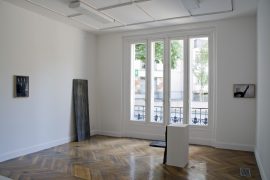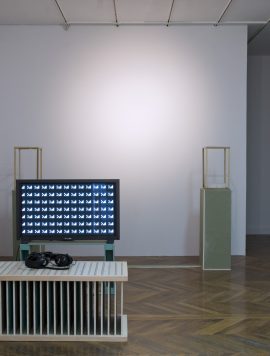Through Body & Text
The exhibition “À corps & à textes” is part of the event OUT IN THE SUN / SUMMER IN THE ART CENTRES 2009 initiated by d.c.a, the French Association for the Development of Art Centres. Among the 44 original tourist itineraries dreamt up by art centres, La Galerie, Contemporary art centre will suggest from 2 June to 25 July to its visitors ideas to discover sites of contemporary architecture, landscape gardens, public art commissions, as well as the addresses of inventive restaurants and design hotels.
If well thought through, the first encounter with what is simply referred to as ‘typography’ is rather disconcerting: there, graphically arranged on the page, the scission between signifier and signified is studied and formally developed to reach a communicative efficiency. The constructive elements are still the same – a text, its body and the message – but the interpretative lens paradigmatically changes: if the writing remains a fluid stream of subjective idiosyncrasies, at the same time it becomes a body in the space, a body occupying space. On a similar unsettling level, the exhibition “À corps & à textes” analyzes a certain typographical nature of the complex relationship between coexisting strategies of employing writing as a motor for artistic creation.
The heterogeneous works of the seven invited artists – most of whom are showing in France for the first time – position themselves between an exquisite rarefaction of the art object through subjective narrations and an analytic investigation of language as a medium for regaining the physicality of the work. Through the tortuous itineraries undertaken by these different practices, the exhibition explores the countless potentialities of writing as a body that engages both with physical and mental spaces.
It is clear that, when talking of typography in relation to the work of the seven artists of “À corps & à textes”, I’m referring to a hybridized version of this complex tool to understand cultural developments. Indeed I’m not alluding to the art of arranging types and modifying glyphs by using a variety of illustration techniques. I’m instead thinking of intuitive writing practices considered as ‘that by which something is subjectively symbolized or figured’, or as ‘that by which something regains its status of thing between things, regains its being in the world’.
Maybe it would be more appropriate to say that I’m talking of a certain typographical attitude between the invited artists and the production of their work, a relation constantly kept fluid by the unsettlement of their writings. It is in this openness to fluidity and in the consequent exclusion of any crystallized focus on the formalization of the work, that the heterogeneous and partially overlapping practices of the artists of “À corps & à textes” find a common conceptual ground. This dilated idea of written words relates to the very same human ability to capture glimpses of reality and simultaneously transform them into bodies, existing both as ephemeral elements of subjective realities and independent objects physically returned to the world.
The intriguing balance between writing as shapeless process of abstraction and concretisation is at the core of the exhibition. This idea can be further examplified through two significant anecdotes: in 1961 Pier Paolo Pasolini leaves poetry and debuts as a director, converging into his cinematic realism the allegorical power of his poetic writing. In Pasolini’s cinema the application of his lyrical narration onto a realist perception of the world, translates into complex mythologies able to pierce the thick intelligibility of the reality as it unfolds in front of the author’s eyes. Just ten years before, the French writer Raymond Queneau published his Petite cosmogonie portative, a lyrical research into the creative qualities of analytic language. Queneau adopts a language as distant from poetry as it can allow for the incorporation of scientific terms and themes. Then, with this very language, he writes a unique lyrical work, a literary cosmogony with a scientific validity. These two complex and divergent events perfectly exemplify how the existence of analytic and poetic elements could transmute the most subjective description of reality into mythology, and the most scrupulous analysis of language into a physical object.
The possible shadings are infinite, countless as the narrative forms used by the invited artists: the day-to-day, the crepuscular, the intimate and the naturalistic. And then again: the detached, the rational, the calibrated and the analytical. From Clare Gasson’s and Orla Barry’s researches into writing as imprint of the artist’s subjectivity, to Alexandre Singh’s fictive use of narration as a catalyst for alternative histories. From Michael Dean’s and Falke Pisano’s analytic research into written words as physical and conceptual objects, to Richard T. Walker’s disarming use of writing as psychological link between interior and exterior world, until Reto Pulfer’s use of written words as performable mnemonic exercise through images and objects. Words are important, and the exhibition is an attempt to analyse the consequences of such assertion through a group of artists that make written words the centre of their practice.
The point of encounter should be found precisely in the fluidity of this ‘certain typographical attitude’ shared by the different works and applied in the balance between the piece and the overflowing written discourse accompanying it. This encounter is physically shown in the central room of the exhibition space completing the conceptual spectrum of the show by underlining not just the different strategies of employing writing at the core of artistic practices, but also the importance to reflect on our cultural necessity to write, write, write.
Francesco Pedraglio
Translated by Gabriel Baldessin
around the exhibition
-
30/05/2009
Performances during the opening:
from 6:00 to 10:00 pm
Reto Pulfer, La Galerie
8:30 pm
Alexandre Singh, residency studio, Noisy-le-Sec. -
09/06/2009
From 7:00 to 9:00 pm
“A time for art” art criticism for all led by Sally Bonn, in partnership with the Centre de Philosophie de l’art, Paris 1 Panthéon-Sorbonne University. -
18/06/2009
From 7:00 to 8:30 pm
Lecture discussion with Jérôme Poret, artist, about the links between sound and visual arts within the framework of “Films’ music ” festival in Noisy-le-Sec, at Roger-Gouhier multimedia library, Noisy-le-Sec. -
23/06/2009
From 7:00 to 9:00 pm
“A time for art” art criticism for all led by Sally Bonn. -
26/06/2009
Performances evening with Alex Cecchetti and Marcelline Delbecq.
-
03/07/2009
From 7:30 to 9:00 pm
Francesco Pedraglio invites curators and artists whom he met in residency: reading and screening evening, residency studio, Noisy-le-Sec.





